Healthcare Leadership: Strategies for Reducing Hospital Infections
VerifiedAdded on 2023/03/23
|14
|3961
|86
Essay
AI Summary
This essay addresses the critical issue of hospital-acquired infections (HAIs) and proposes two key strategies for their reduction: maintaining hand hygiene and implementing aseptic techniques. It highlights the significant impact of HAIs on patient morbidity, mortality, and healthcare costs, particularly within the Australian context, where a national infection surveillance system is lacking. The essay details the seven steps of hand hygiene and the five WHO guidelines, emphasizing the role of healthcare worker education and the importance of addressing barriers to compliance. It also explores the aseptic technique, focusing on the sterilization of clinical instruments and the environment, and the need for registered nurses to govern and implement these practices. The essay concludes that the integration of these strategies, supported by strong leadership and clinical governance, is essential for reducing the incidence of HAIs and improving patient outcomes. Desklib provides access to similar essays and study tools.
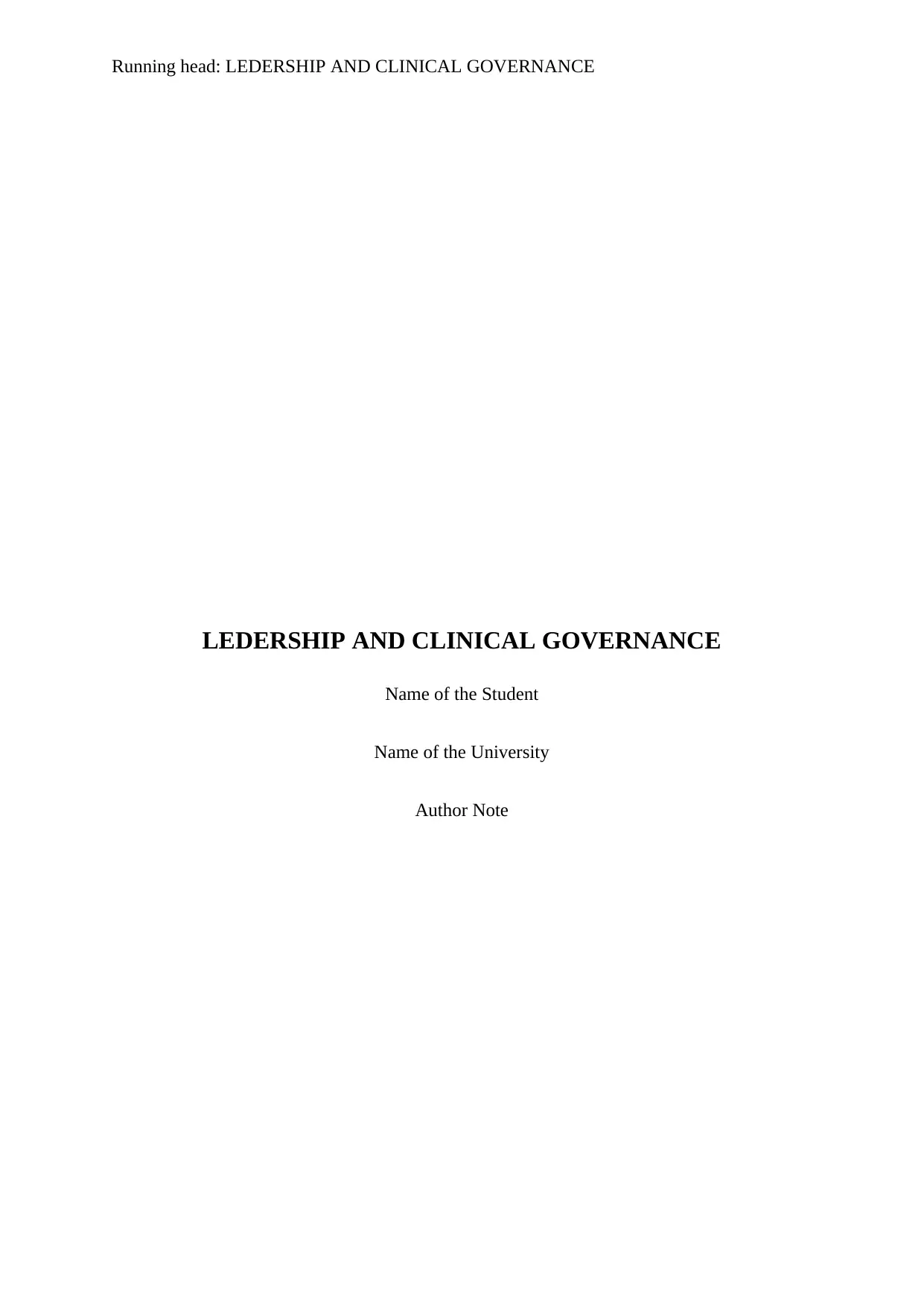
Running head: LEDERSHIP AND CLINICAL GOVERNANCE
LEDERSHIP AND CLINICAL GOVERNANCE
Name of the Student
Name of the University
Author Note
LEDERSHIP AND CLINICAL GOVERNANCE
Name of the Student
Name of the University
Author Note
Paraphrase This Document
Need a fresh take? Get an instant paraphrase of this document with our AI Paraphraser
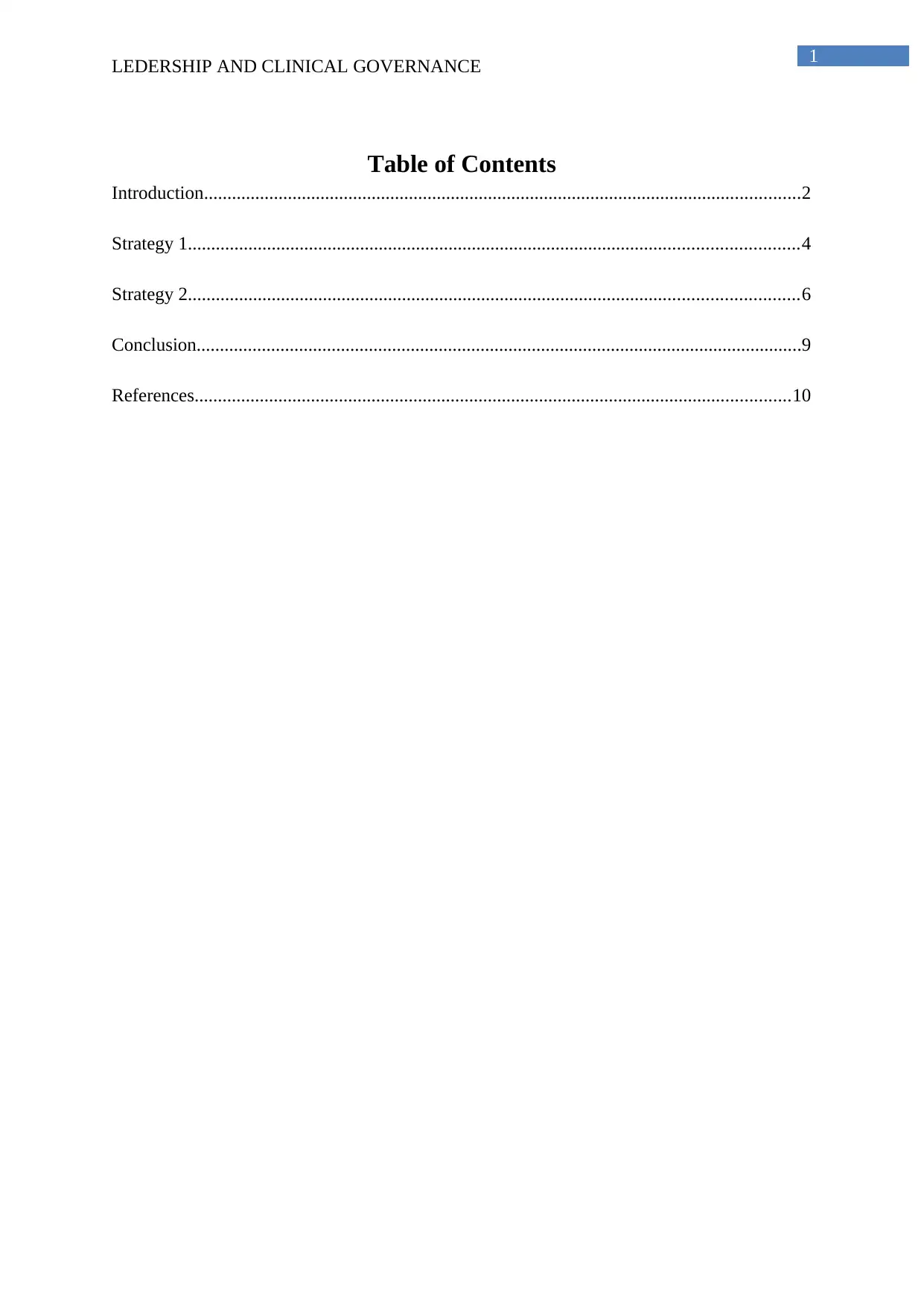
1
LEDERSHIP AND CLINICAL GOVERNANCE
Table of Contents
Introduction................................................................................................................................2
Strategy 1...................................................................................................................................4
Strategy 2...................................................................................................................................6
Conclusion..................................................................................................................................9
References................................................................................................................................10
LEDERSHIP AND CLINICAL GOVERNANCE
Table of Contents
Introduction................................................................................................................................2
Strategy 1...................................................................................................................................4
Strategy 2...................................................................................................................................6
Conclusion..................................................................................................................................9
References................................................................................................................................10
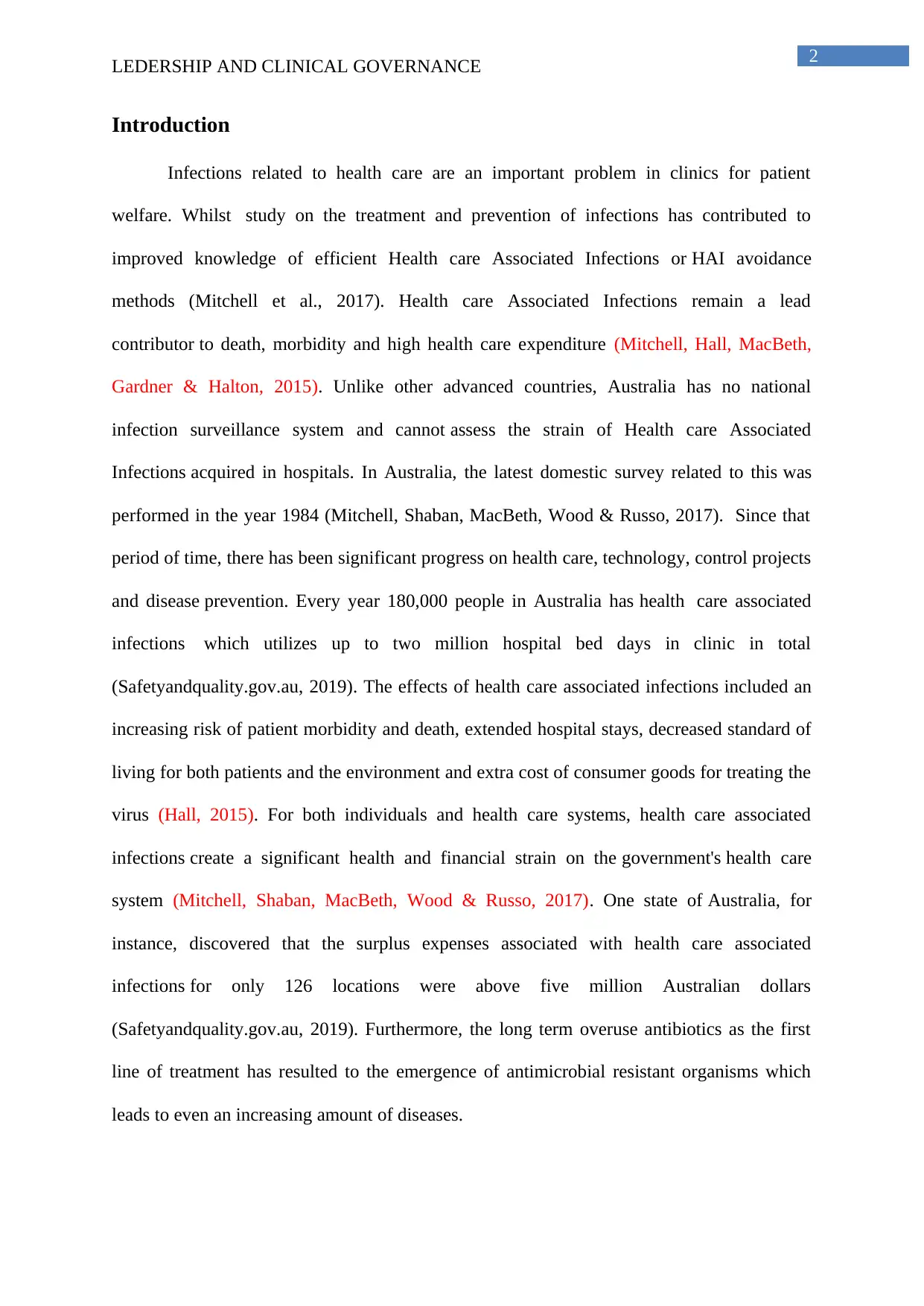
2
LEDERSHIP AND CLINICAL GOVERNANCE
Introduction
Infections related to health care are an important problem in clinics for patient
welfare. Whilst study on the treatment and prevention of infections has contributed to
improved knowledge of efficient Health care Associated Infections or HAI avoidance
methods (Mitchell et al., 2017). Health care Associated Infections remain a lead
contributor to death, morbidity and high health care expenditure (Mitchell, Hall, MacBeth,
Gardner & Halton, 2015). Unlike other advanced countries, Australia has no national
infection surveillance system and cannot assess the strain of Health care Associated
Infections acquired in hospitals. In Australia, the latest domestic survey related to this was
performed in the year 1984 (Mitchell, Shaban, MacBeth, Wood & Russo, 2017). Since that
period of time, there has been significant progress on health care, technology, control projects
and disease prevention. Every year 180,000 people in Australia has health care associated
infections which utilizes up to two million hospital bed days in clinic in total
(Safetyandquality.gov.au, 2019). The effects of health care associated infections included an
increasing risk of patient morbidity and death, extended hospital stays, decreased standard of
living for both patients and the environment and extra cost of consumer goods for treating the
virus (Hall, 2015). For both individuals and health care systems, health care associated
infections create a significant health and financial strain on the government's health care
system (Mitchell, Shaban, MacBeth, Wood & Russo, 2017). One state of Australia, for
instance, discovered that the surplus expenses associated with health care associated
infections for only 126 locations were above five million Australian dollars
(Safetyandquality.gov.au, 2019). Furthermore, the long term overuse antibiotics as the first
line of treatment has resulted to the emergence of antimicrobial resistant organisms which
leads to even an increasing amount of diseases.
LEDERSHIP AND CLINICAL GOVERNANCE
Introduction
Infections related to health care are an important problem in clinics for patient
welfare. Whilst study on the treatment and prevention of infections has contributed to
improved knowledge of efficient Health care Associated Infections or HAI avoidance
methods (Mitchell et al., 2017). Health care Associated Infections remain a lead
contributor to death, morbidity and high health care expenditure (Mitchell, Hall, MacBeth,
Gardner & Halton, 2015). Unlike other advanced countries, Australia has no national
infection surveillance system and cannot assess the strain of Health care Associated
Infections acquired in hospitals. In Australia, the latest domestic survey related to this was
performed in the year 1984 (Mitchell, Shaban, MacBeth, Wood & Russo, 2017). Since that
period of time, there has been significant progress on health care, technology, control projects
and disease prevention. Every year 180,000 people in Australia has health care associated
infections which utilizes up to two million hospital bed days in clinic in total
(Safetyandquality.gov.au, 2019). The effects of health care associated infections included an
increasing risk of patient morbidity and death, extended hospital stays, decreased standard of
living for both patients and the environment and extra cost of consumer goods for treating the
virus (Hall, 2015). For both individuals and health care systems, health care associated
infections create a significant health and financial strain on the government's health care
system (Mitchell, Shaban, MacBeth, Wood & Russo, 2017). One state of Australia, for
instance, discovered that the surplus expenses associated with health care associated
infections for only 126 locations were above five million Australian dollars
(Safetyandquality.gov.au, 2019). Furthermore, the long term overuse antibiotics as the first
line of treatment has resulted to the emergence of antimicrobial resistant organisms which
leads to even an increasing amount of diseases.
⊘ This is a preview!⊘
Do you want full access?
Subscribe today to unlock all pages.

Trusted by 1+ million students worldwide
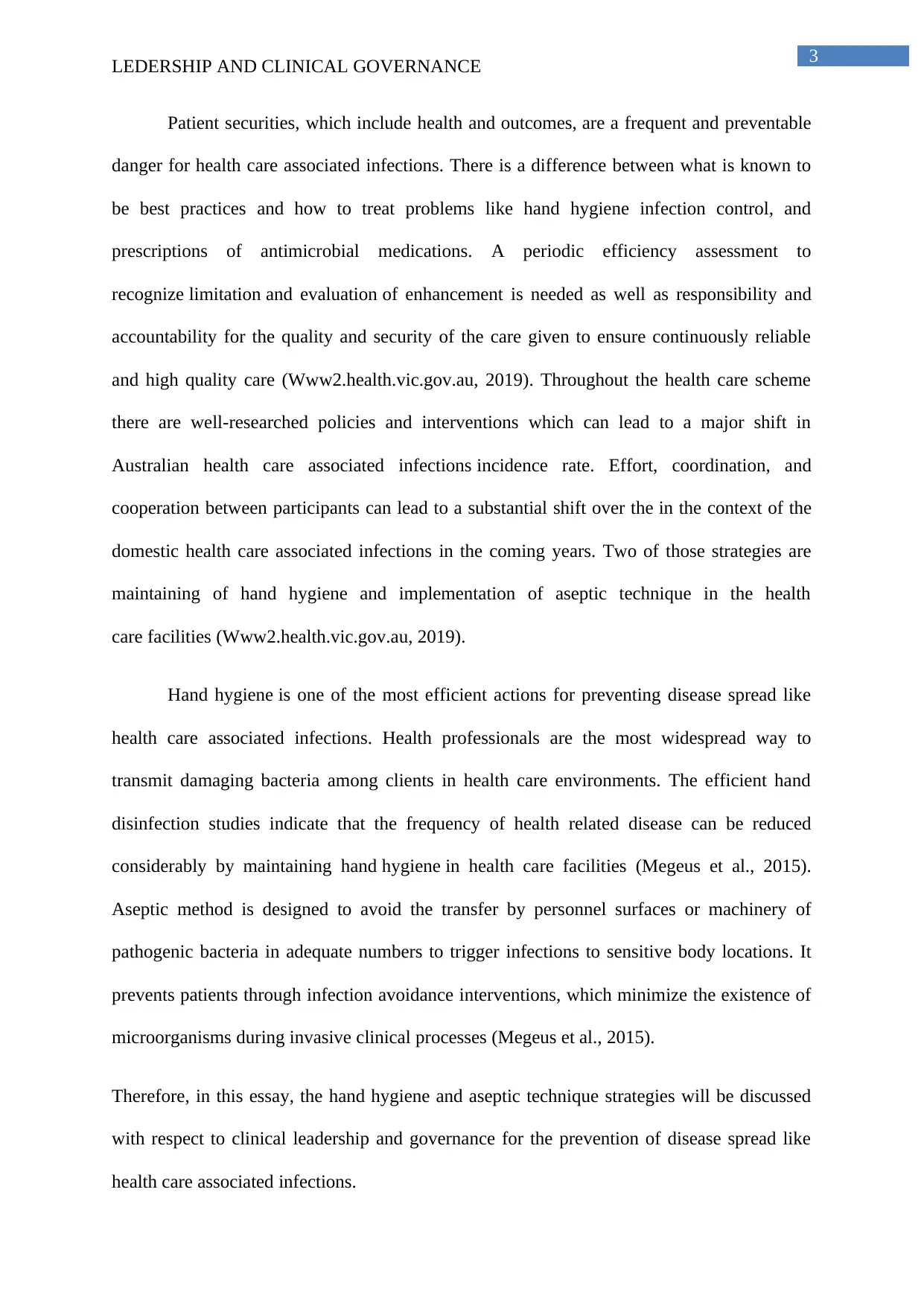
3
LEDERSHIP AND CLINICAL GOVERNANCE
Patient securities, which include health and outcomes, are a frequent and preventable
danger for health care associated infections. There is a difference between what is known to
be best practices and how to treat problems like hand hygiene infection control, and
prescriptions of antimicrobial medications. A periodic efficiency assessment to
recognize limitation and evaluation of enhancement is needed as well as responsibility and
accountability for the quality and security of the care given to ensure continuously reliable
and high quality care (Www2.health.vic.gov.au, 2019). Throughout the health care scheme
there are well-researched policies and interventions which can lead to a major shift in
Australian health care associated infections incidence rate. Effort, coordination, and
cooperation between participants can lead to a substantial shift over the in the context of the
domestic health care associated infections in the coming years. Two of those strategies are
maintaining of hand hygiene and implementation of aseptic technique in the health
care facilities (Www2.health.vic.gov.au, 2019).
Hand hygiene is one of the most efficient actions for preventing disease spread like
health care associated infections. Health professionals are the most widespread way to
transmit damaging bacteria among clients in health care environments. The efficient hand
disinfection studies indicate that the frequency of health related disease can be reduced
considerably by maintaining hand hygiene in health care facilities (Megeus et al., 2015).
Aseptic method is designed to avoid the transfer by personnel surfaces or machinery of
pathogenic bacteria in adequate numbers to trigger infections to sensitive body locations. It
prevents patients through infection avoidance interventions, which minimize the existence of
microorganisms during invasive clinical processes (Megeus et al., 2015).
Therefore, in this essay, the hand hygiene and aseptic technique strategies will be discussed
with respect to clinical leadership and governance for the prevention of disease spread like
health care associated infections.
LEDERSHIP AND CLINICAL GOVERNANCE
Patient securities, which include health and outcomes, are a frequent and preventable
danger for health care associated infections. There is a difference between what is known to
be best practices and how to treat problems like hand hygiene infection control, and
prescriptions of antimicrobial medications. A periodic efficiency assessment to
recognize limitation and evaluation of enhancement is needed as well as responsibility and
accountability for the quality and security of the care given to ensure continuously reliable
and high quality care (Www2.health.vic.gov.au, 2019). Throughout the health care scheme
there are well-researched policies and interventions which can lead to a major shift in
Australian health care associated infections incidence rate. Effort, coordination, and
cooperation between participants can lead to a substantial shift over the in the context of the
domestic health care associated infections in the coming years. Two of those strategies are
maintaining of hand hygiene and implementation of aseptic technique in the health
care facilities (Www2.health.vic.gov.au, 2019).
Hand hygiene is one of the most efficient actions for preventing disease spread like
health care associated infections. Health professionals are the most widespread way to
transmit damaging bacteria among clients in health care environments. The efficient hand
disinfection studies indicate that the frequency of health related disease can be reduced
considerably by maintaining hand hygiene in health care facilities (Megeus et al., 2015).
Aseptic method is designed to avoid the transfer by personnel surfaces or machinery of
pathogenic bacteria in adequate numbers to trigger infections to sensitive body locations. It
prevents patients through infection avoidance interventions, which minimize the existence of
microorganisms during invasive clinical processes (Megeus et al., 2015).
Therefore, in this essay, the hand hygiene and aseptic technique strategies will be discussed
with respect to clinical leadership and governance for the prevention of disease spread like
health care associated infections.
Paraphrase This Document
Need a fresh take? Get an instant paraphrase of this document with our AI Paraphraser
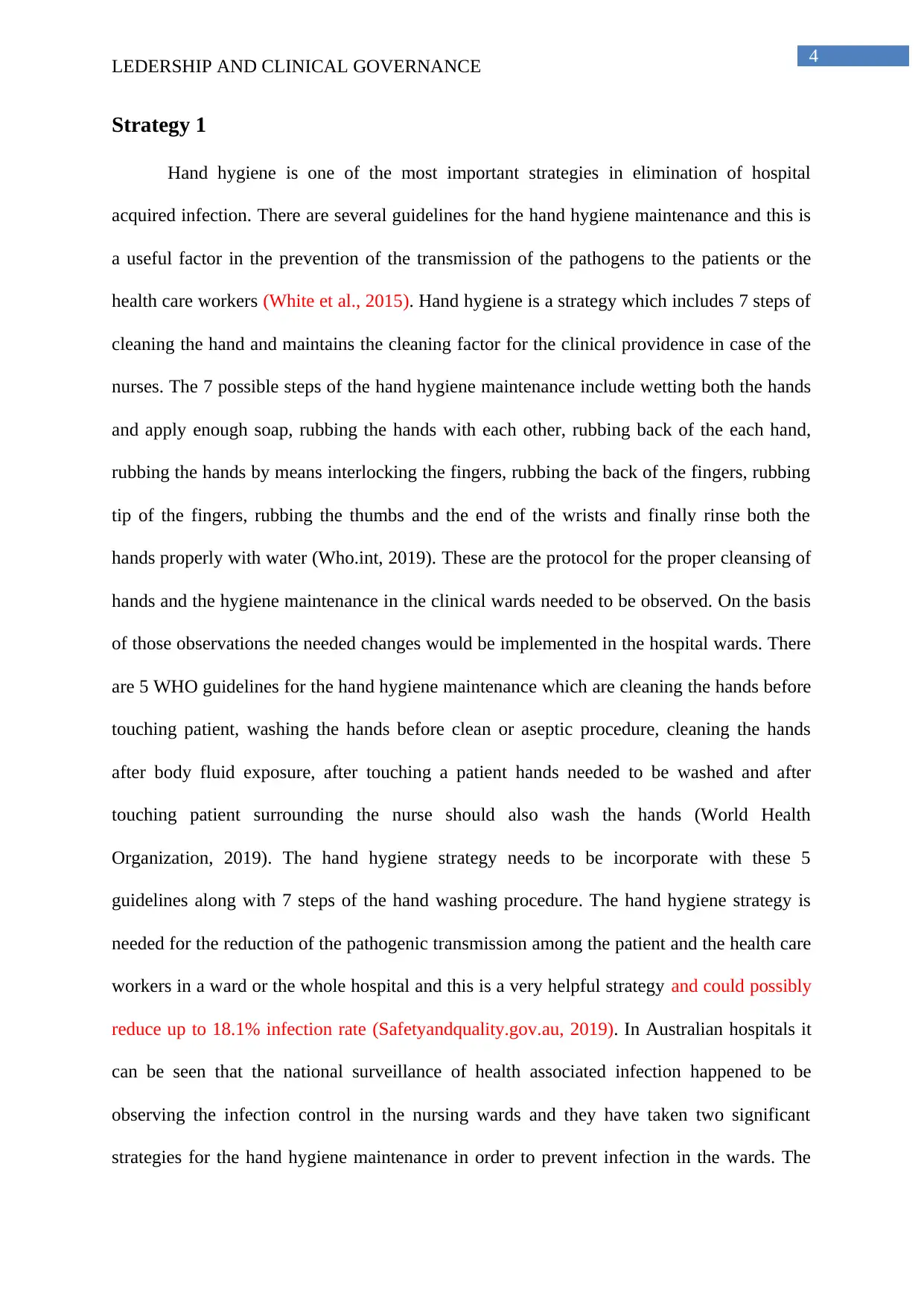
4
LEDERSHIP AND CLINICAL GOVERNANCE
Strategy 1
Hand hygiene is one of the most important strategies in elimination of hospital
acquired infection. There are several guidelines for the hand hygiene maintenance and this is
a useful factor in the prevention of the transmission of the pathogens to the patients or the
health care workers (White et al., 2015). Hand hygiene is a strategy which includes 7 steps of
cleaning the hand and maintains the cleaning factor for the clinical providence in case of the
nurses. The 7 possible steps of the hand hygiene maintenance include wetting both the hands
and apply enough soap, rubbing the hands with each other, rubbing back of the each hand,
rubbing the hands by means interlocking the fingers, rubbing the back of the fingers, rubbing
tip of the fingers, rubbing the thumbs and the end of the wrists and finally rinse both the
hands properly with water (Who.int, 2019). These are the protocol for the proper cleansing of
hands and the hygiene maintenance in the clinical wards needed to be observed. On the basis
of those observations the needed changes would be implemented in the hospital wards. There
are 5 WHO guidelines for the hand hygiene maintenance which are cleaning the hands before
touching patient, washing the hands before clean or aseptic procedure, cleaning the hands
after body fluid exposure, after touching a patient hands needed to be washed and after
touching patient surrounding the nurse should also wash the hands (World Health
Organization, 2019). The hand hygiene strategy needs to be incorporate with these 5
guidelines along with 7 steps of the hand washing procedure. The hand hygiene strategy is
needed for the reduction of the pathogenic transmission among the patient and the health care
workers in a ward or the whole hospital and this is a very helpful strategy and could possibly
reduce up to 18.1% infection rate (Safetyandquality.gov.au, 2019). In Australian hospitals it
can be seen that the national surveillance of health associated infection happened to be
observing the infection control in the nursing wards and they have taken two significant
strategies for the hand hygiene maintenance in order to prevent infection in the wards. The
LEDERSHIP AND CLINICAL GOVERNANCE
Strategy 1
Hand hygiene is one of the most important strategies in elimination of hospital
acquired infection. There are several guidelines for the hand hygiene maintenance and this is
a useful factor in the prevention of the transmission of the pathogens to the patients or the
health care workers (White et al., 2015). Hand hygiene is a strategy which includes 7 steps of
cleaning the hand and maintains the cleaning factor for the clinical providence in case of the
nurses. The 7 possible steps of the hand hygiene maintenance include wetting both the hands
and apply enough soap, rubbing the hands with each other, rubbing back of the each hand,
rubbing the hands by means interlocking the fingers, rubbing the back of the fingers, rubbing
tip of the fingers, rubbing the thumbs and the end of the wrists and finally rinse both the
hands properly with water (Who.int, 2019). These are the protocol for the proper cleansing of
hands and the hygiene maintenance in the clinical wards needed to be observed. On the basis
of those observations the needed changes would be implemented in the hospital wards. There
are 5 WHO guidelines for the hand hygiene maintenance which are cleaning the hands before
touching patient, washing the hands before clean or aseptic procedure, cleaning the hands
after body fluid exposure, after touching a patient hands needed to be washed and after
touching patient surrounding the nurse should also wash the hands (World Health
Organization, 2019). The hand hygiene strategy needs to be incorporate with these 5
guidelines along with 7 steps of the hand washing procedure. The hand hygiene strategy is
needed for the reduction of the pathogenic transmission among the patient and the health care
workers in a ward or the whole hospital and this is a very helpful strategy and could possibly
reduce up to 18.1% infection rate (Safetyandquality.gov.au, 2019). In Australian hospitals it
can be seen that the national surveillance of health associated infection happened to be
observing the infection control in the nursing wards and they have taken two significant
strategies for the hand hygiene maintenance in order to prevent infection in the wards. The
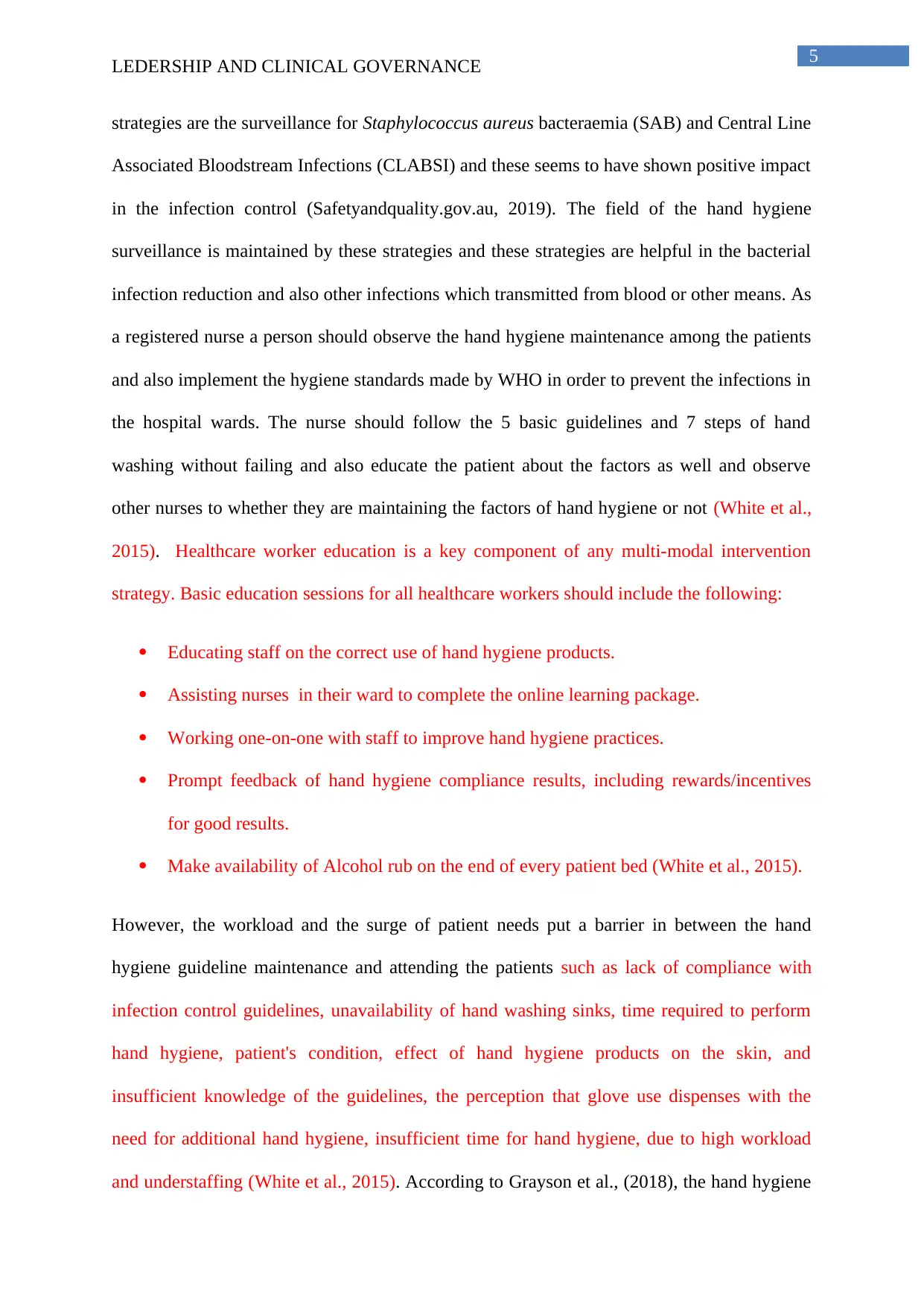
5
LEDERSHIP AND CLINICAL GOVERNANCE
strategies are the surveillance for Staphylococcus aureus bacteraemia (SAB) and Central Line
Associated Bloodstream Infections (CLABSI) and these seems to have shown positive impact
in the infection control (Safetyandquality.gov.au, 2019). The field of the hand hygiene
surveillance is maintained by these strategies and these strategies are helpful in the bacterial
infection reduction and also other infections which transmitted from blood or other means. As
a registered nurse a person should observe the hand hygiene maintenance among the patients
and also implement the hygiene standards made by WHO in order to prevent the infections in
the hospital wards. The nurse should follow the 5 basic guidelines and 7 steps of hand
washing without failing and also educate the patient about the factors as well and observe
other nurses to whether they are maintaining the factors of hand hygiene or not (White et al.,
2015). Healthcare worker education is a key component of any multi-modal intervention
strategy. Basic education sessions for all healthcare workers should include the following:
Educating staff on the correct use of hand hygiene products.
Assisting nurses in their ward to complete the online learning package.
Working one-on-one with staff to improve hand hygiene practices.
Prompt feedback of hand hygiene compliance results, including rewards/incentives
for good results.
Make availability of Alcohol rub on the end of every patient bed (White et al., 2015).
However, the workload and the surge of patient needs put a barrier in between the hand
hygiene guideline maintenance and attending the patients such as lack of compliance with
infection control guidelines, unavailability of hand washing sinks, time required to perform
hand hygiene, patient's condition, effect of hand hygiene products on the skin, and
insufficient knowledge of the guidelines, the perception that glove use dispenses with the
need for additional hand hygiene, insufficient time for hand hygiene, due to high workload
and understaffing (White et al., 2015). According to Grayson et al., (2018), the hand hygiene
LEDERSHIP AND CLINICAL GOVERNANCE
strategies are the surveillance for Staphylococcus aureus bacteraemia (SAB) and Central Line
Associated Bloodstream Infections (CLABSI) and these seems to have shown positive impact
in the infection control (Safetyandquality.gov.au, 2019). The field of the hand hygiene
surveillance is maintained by these strategies and these strategies are helpful in the bacterial
infection reduction and also other infections which transmitted from blood or other means. As
a registered nurse a person should observe the hand hygiene maintenance among the patients
and also implement the hygiene standards made by WHO in order to prevent the infections in
the hospital wards. The nurse should follow the 5 basic guidelines and 7 steps of hand
washing without failing and also educate the patient about the factors as well and observe
other nurses to whether they are maintaining the factors of hand hygiene or not (White et al.,
2015). Healthcare worker education is a key component of any multi-modal intervention
strategy. Basic education sessions for all healthcare workers should include the following:
Educating staff on the correct use of hand hygiene products.
Assisting nurses in their ward to complete the online learning package.
Working one-on-one with staff to improve hand hygiene practices.
Prompt feedback of hand hygiene compliance results, including rewards/incentives
for good results.
Make availability of Alcohol rub on the end of every patient bed (White et al., 2015).
However, the workload and the surge of patient needs put a barrier in between the hand
hygiene guideline maintenance and attending the patients such as lack of compliance with
infection control guidelines, unavailability of hand washing sinks, time required to perform
hand hygiene, patient's condition, effect of hand hygiene products on the skin, and
insufficient knowledge of the guidelines, the perception that glove use dispenses with the
need for additional hand hygiene, insufficient time for hand hygiene, due to high workload
and understaffing (White et al., 2015). According to Grayson et al., (2018), the hand hygiene
⊘ This is a preview!⊘
Do you want full access?
Subscribe today to unlock all pages.

Trusted by 1+ million students worldwide
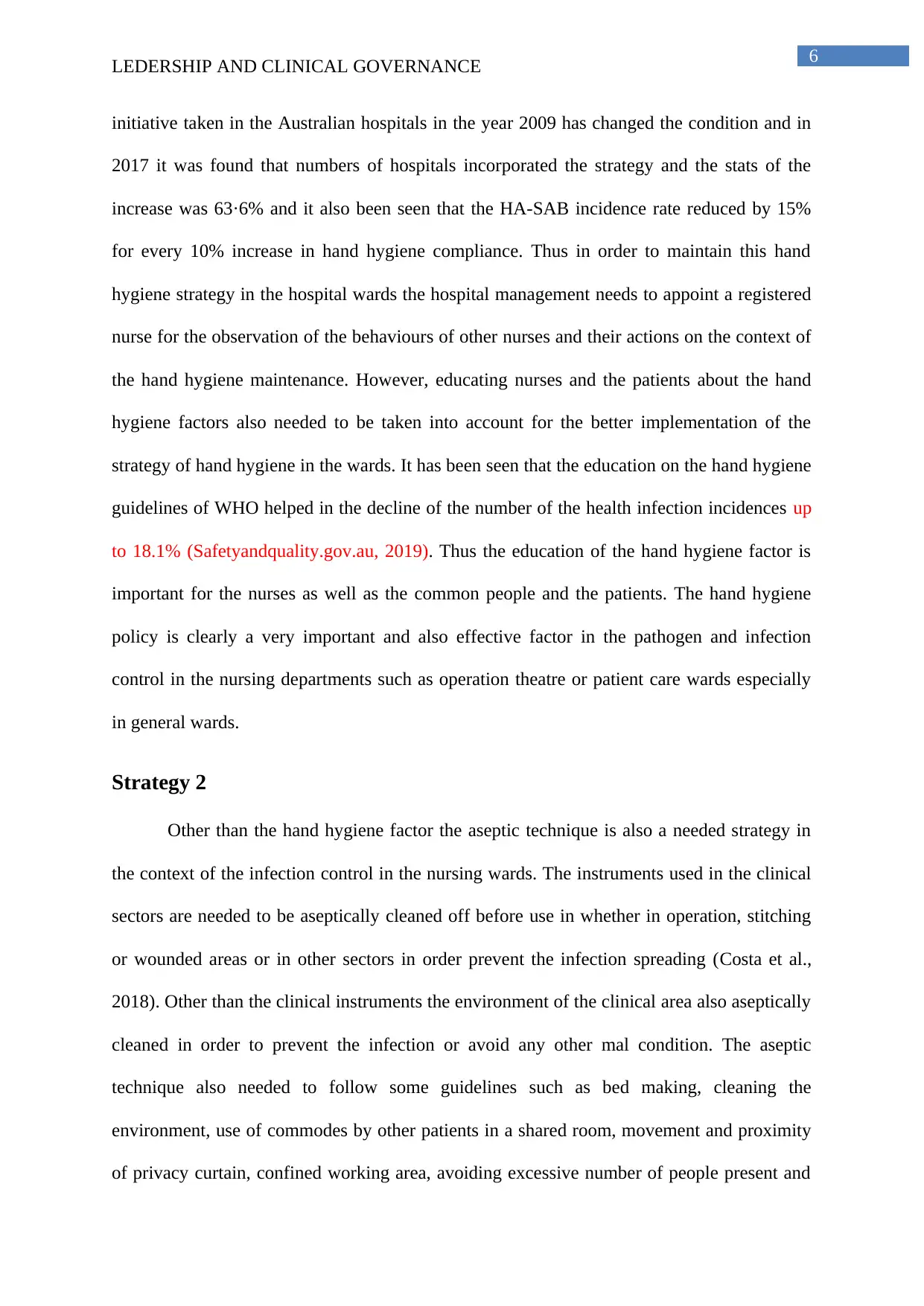
6
LEDERSHIP AND CLINICAL GOVERNANCE
initiative taken in the Australian hospitals in the year 2009 has changed the condition and in
2017 it was found that numbers of hospitals incorporated the strategy and the stats of the
increase was 63·6% and it also been seen that the HA-SAB incidence rate reduced by 15%
for every 10% increase in hand hygiene compliance. Thus in order to maintain this hand
hygiene strategy in the hospital wards the hospital management needs to appoint a registered
nurse for the observation of the behaviours of other nurses and their actions on the context of
the hand hygiene maintenance. However, educating nurses and the patients about the hand
hygiene factors also needed to be taken into account for the better implementation of the
strategy of hand hygiene in the wards. It has been seen that the education on the hand hygiene
guidelines of WHO helped in the decline of the number of the health infection incidences up
to 18.1% (Safetyandquality.gov.au, 2019). Thus the education of the hand hygiene factor is
important for the nurses as well as the common people and the patients. The hand hygiene
policy is clearly a very important and also effective factor in the pathogen and infection
control in the nursing departments such as operation theatre or patient care wards especially
in general wards.
Strategy 2
Other than the hand hygiene factor the aseptic technique is also a needed strategy in
the context of the infection control in the nursing wards. The instruments used in the clinical
sectors are needed to be aseptically cleaned off before use in whether in operation, stitching
or wounded areas or in other sectors in order prevent the infection spreading (Costa et al.,
2018). Other than the clinical instruments the environment of the clinical area also aseptically
cleaned in order to prevent the infection or avoid any other mal condition. The aseptic
technique also needed to follow some guidelines such as bed making, cleaning the
environment, use of commodes by other patients in a shared room, movement and proximity
of privacy curtain, confined working area, avoiding excessive number of people present and
LEDERSHIP AND CLINICAL GOVERNANCE
initiative taken in the Australian hospitals in the year 2009 has changed the condition and in
2017 it was found that numbers of hospitals incorporated the strategy and the stats of the
increase was 63·6% and it also been seen that the HA-SAB incidence rate reduced by 15%
for every 10% increase in hand hygiene compliance. Thus in order to maintain this hand
hygiene strategy in the hospital wards the hospital management needs to appoint a registered
nurse for the observation of the behaviours of other nurses and their actions on the context of
the hand hygiene maintenance. However, educating nurses and the patients about the hand
hygiene factors also needed to be taken into account for the better implementation of the
strategy of hand hygiene in the wards. It has been seen that the education on the hand hygiene
guidelines of WHO helped in the decline of the number of the health infection incidences up
to 18.1% (Safetyandquality.gov.au, 2019). Thus the education of the hand hygiene factor is
important for the nurses as well as the common people and the patients. The hand hygiene
policy is clearly a very important and also effective factor in the pathogen and infection
control in the nursing departments such as operation theatre or patient care wards especially
in general wards.
Strategy 2
Other than the hand hygiene factor the aseptic technique is also a needed strategy in
the context of the infection control in the nursing wards. The instruments used in the clinical
sectors are needed to be aseptically cleaned off before use in whether in operation, stitching
or wounded areas or in other sectors in order prevent the infection spreading (Costa et al.,
2018). Other than the clinical instruments the environment of the clinical area also aseptically
cleaned in order to prevent the infection or avoid any other mal condition. The aseptic
technique also needed to follow some guidelines such as bed making, cleaning the
environment, use of commodes by other patients in a shared room, movement and proximity
of privacy curtain, confined working area, avoiding excessive number of people present and
Paraphrase This Document
Need a fresh take? Get an instant paraphrase of this document with our AI Paraphraser
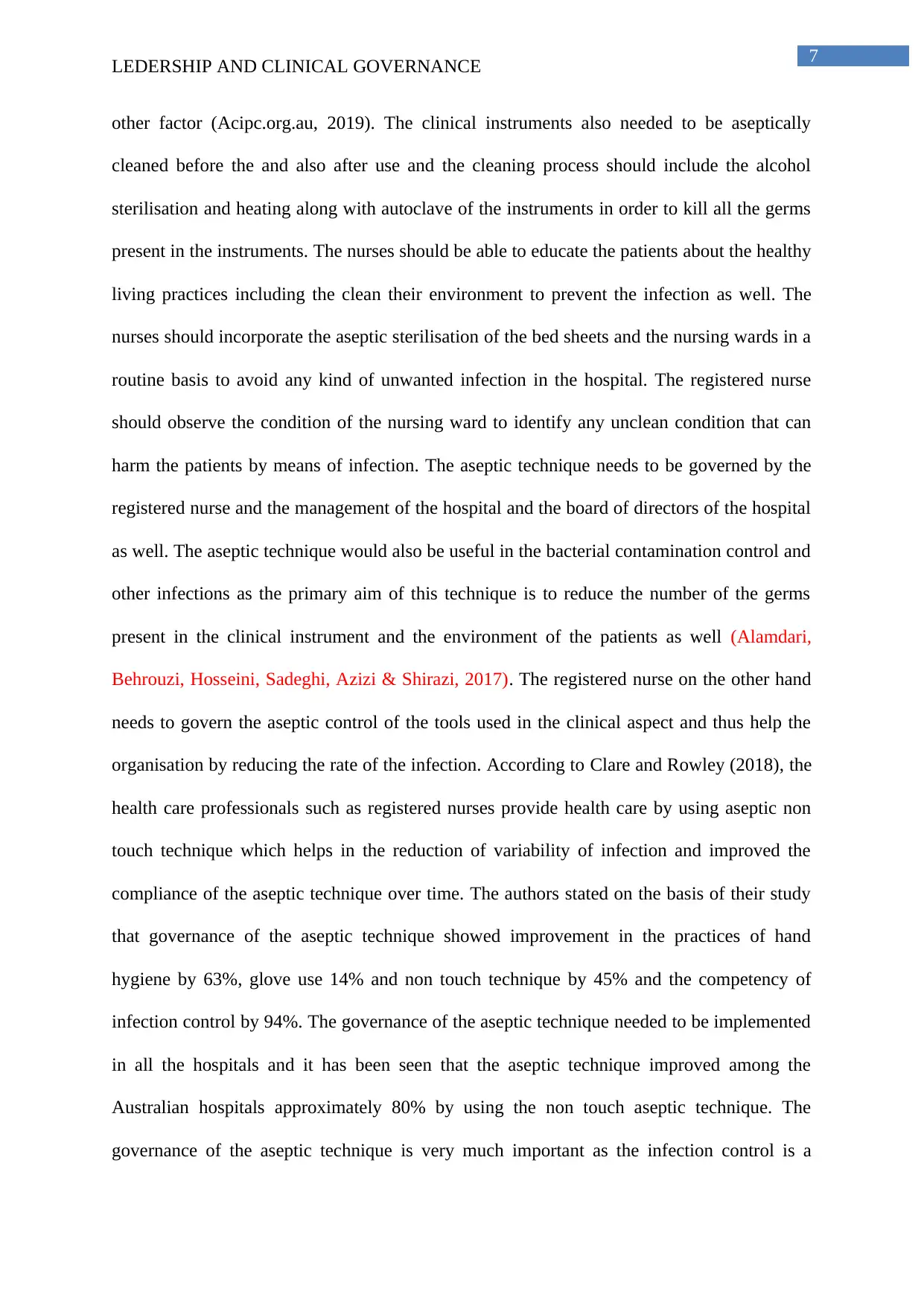
7
LEDERSHIP AND CLINICAL GOVERNANCE
other factor (Acipc.org.au, 2019). The clinical instruments also needed to be aseptically
cleaned before the and also after use and the cleaning process should include the alcohol
sterilisation and heating along with autoclave of the instruments in order to kill all the germs
present in the instruments. The nurses should be able to educate the patients about the healthy
living practices including the clean their environment to prevent the infection as well. The
nurses should incorporate the aseptic sterilisation of the bed sheets and the nursing wards in a
routine basis to avoid any kind of unwanted infection in the hospital. The registered nurse
should observe the condition of the nursing ward to identify any unclean condition that can
harm the patients by means of infection. The aseptic technique needs to be governed by the
registered nurse and the management of the hospital and the board of directors of the hospital
as well. The aseptic technique would also be useful in the bacterial contamination control and
other infections as the primary aim of this technique is to reduce the number of the germs
present in the clinical instrument and the environment of the patients as well (Alamdari,
Behrouzi, Hosseini, Sadeghi, Azizi & Shirazi, 2017). The registered nurse on the other hand
needs to govern the aseptic control of the tools used in the clinical aspect and thus help the
organisation by reducing the rate of the infection. According to Clare and Rowley (2018), the
health care professionals such as registered nurses provide health care by using aseptic non
touch technique which helps in the reduction of variability of infection and improved the
compliance of the aseptic technique over time. The authors stated on the basis of their study
that governance of the aseptic technique showed improvement in the practices of hand
hygiene by 63%, glove use 14% and non touch technique by 45% and the competency of
infection control by 94%. The governance of the aseptic technique needed to be implemented
in all the hospitals and it has been seen that the aseptic technique improved among the
Australian hospitals approximately 80% by using the non touch aseptic technique. The
governance of the aseptic technique is very much important as the infection control is a
LEDERSHIP AND CLINICAL GOVERNANCE
other factor (Acipc.org.au, 2019). The clinical instruments also needed to be aseptically
cleaned before the and also after use and the cleaning process should include the alcohol
sterilisation and heating along with autoclave of the instruments in order to kill all the germs
present in the instruments. The nurses should be able to educate the patients about the healthy
living practices including the clean their environment to prevent the infection as well. The
nurses should incorporate the aseptic sterilisation of the bed sheets and the nursing wards in a
routine basis to avoid any kind of unwanted infection in the hospital. The registered nurse
should observe the condition of the nursing ward to identify any unclean condition that can
harm the patients by means of infection. The aseptic technique needs to be governed by the
registered nurse and the management of the hospital and the board of directors of the hospital
as well. The aseptic technique would also be useful in the bacterial contamination control and
other infections as the primary aim of this technique is to reduce the number of the germs
present in the clinical instrument and the environment of the patients as well (Alamdari,
Behrouzi, Hosseini, Sadeghi, Azizi & Shirazi, 2017). The registered nurse on the other hand
needs to govern the aseptic control of the tools used in the clinical aspect and thus help the
organisation by reducing the rate of the infection. According to Clare and Rowley (2018), the
health care professionals such as registered nurses provide health care by using aseptic non
touch technique which helps in the reduction of variability of infection and improved the
compliance of the aseptic technique over time. The authors stated on the basis of their study
that governance of the aseptic technique showed improvement in the practices of hand
hygiene by 63%, glove use 14% and non touch technique by 45% and the competency of
infection control by 94%. The governance of the aseptic technique needed to be implemented
in all the hospitals and it has been seen that the aseptic technique improved among the
Australian hospitals approximately 80% by using the non touch aseptic technique. The
governance of the aseptic technique is very much important as the infection control is a
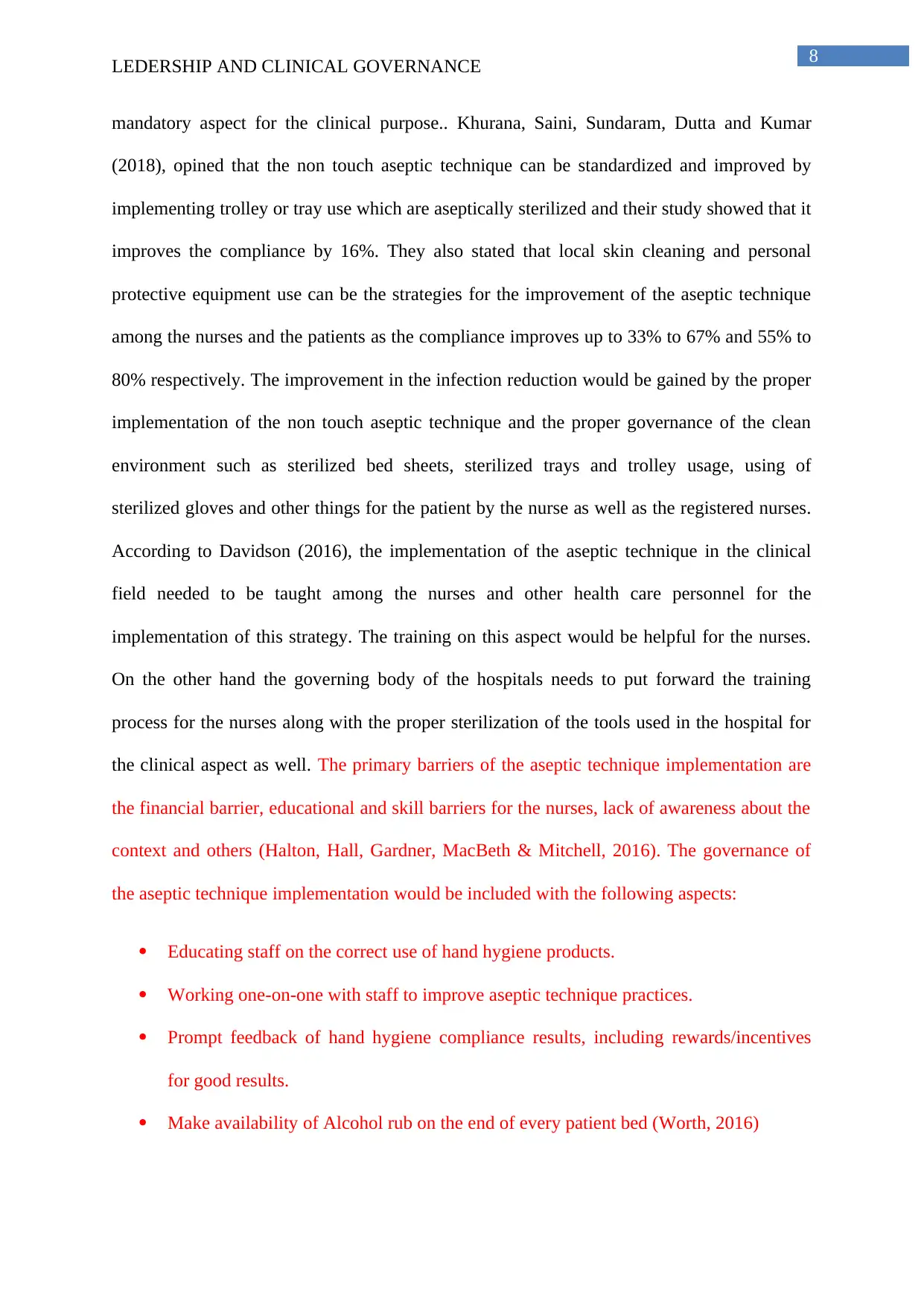
8
LEDERSHIP AND CLINICAL GOVERNANCE
mandatory aspect for the clinical purpose.. Khurana, Saini, Sundaram, Dutta and Kumar
(2018), opined that the non touch aseptic technique can be standardized and improved by
implementing trolley or tray use which are aseptically sterilized and their study showed that it
improves the compliance by 16%. They also stated that local skin cleaning and personal
protective equipment use can be the strategies for the improvement of the aseptic technique
among the nurses and the patients as the compliance improves up to 33% to 67% and 55% to
80% respectively. The improvement in the infection reduction would be gained by the proper
implementation of the non touch aseptic technique and the proper governance of the clean
environment such as sterilized bed sheets, sterilized trays and trolley usage, using of
sterilized gloves and other things for the patient by the nurse as well as the registered nurses.
According to Davidson (2016), the implementation of the aseptic technique in the clinical
field needed to be taught among the nurses and other health care personnel for the
implementation of this strategy. The training on this aspect would be helpful for the nurses.
On the other hand the governing body of the hospitals needs to put forward the training
process for the nurses along with the proper sterilization of the tools used in the hospital for
the clinical aspect as well. The primary barriers of the aseptic technique implementation are
the financial barrier, educational and skill barriers for the nurses, lack of awareness about the
context and others (Halton, Hall, Gardner, MacBeth & Mitchell, 2016). The governance of
the aseptic technique implementation would be included with the following aspects:
Educating staff on the correct use of hand hygiene products.
Working one-on-one with staff to improve aseptic technique practices.
Prompt feedback of hand hygiene compliance results, including rewards/incentives
for good results.
Make availability of Alcohol rub on the end of every patient bed (Worth, 2016)
LEDERSHIP AND CLINICAL GOVERNANCE
mandatory aspect for the clinical purpose.. Khurana, Saini, Sundaram, Dutta and Kumar
(2018), opined that the non touch aseptic technique can be standardized and improved by
implementing trolley or tray use which are aseptically sterilized and their study showed that it
improves the compliance by 16%. They also stated that local skin cleaning and personal
protective equipment use can be the strategies for the improvement of the aseptic technique
among the nurses and the patients as the compliance improves up to 33% to 67% and 55% to
80% respectively. The improvement in the infection reduction would be gained by the proper
implementation of the non touch aseptic technique and the proper governance of the clean
environment such as sterilized bed sheets, sterilized trays and trolley usage, using of
sterilized gloves and other things for the patient by the nurse as well as the registered nurses.
According to Davidson (2016), the implementation of the aseptic technique in the clinical
field needed to be taught among the nurses and other health care personnel for the
implementation of this strategy. The training on this aspect would be helpful for the nurses.
On the other hand the governing body of the hospitals needs to put forward the training
process for the nurses along with the proper sterilization of the tools used in the hospital for
the clinical aspect as well. The primary barriers of the aseptic technique implementation are
the financial barrier, educational and skill barriers for the nurses, lack of awareness about the
context and others (Halton, Hall, Gardner, MacBeth & Mitchell, 2016). The governance of
the aseptic technique implementation would be included with the following aspects:
Educating staff on the correct use of hand hygiene products.
Working one-on-one with staff to improve aseptic technique practices.
Prompt feedback of hand hygiene compliance results, including rewards/incentives
for good results.
Make availability of Alcohol rub on the end of every patient bed (Worth, 2016)
⊘ This is a preview!⊘
Do you want full access?
Subscribe today to unlock all pages.

Trusted by 1+ million students worldwide
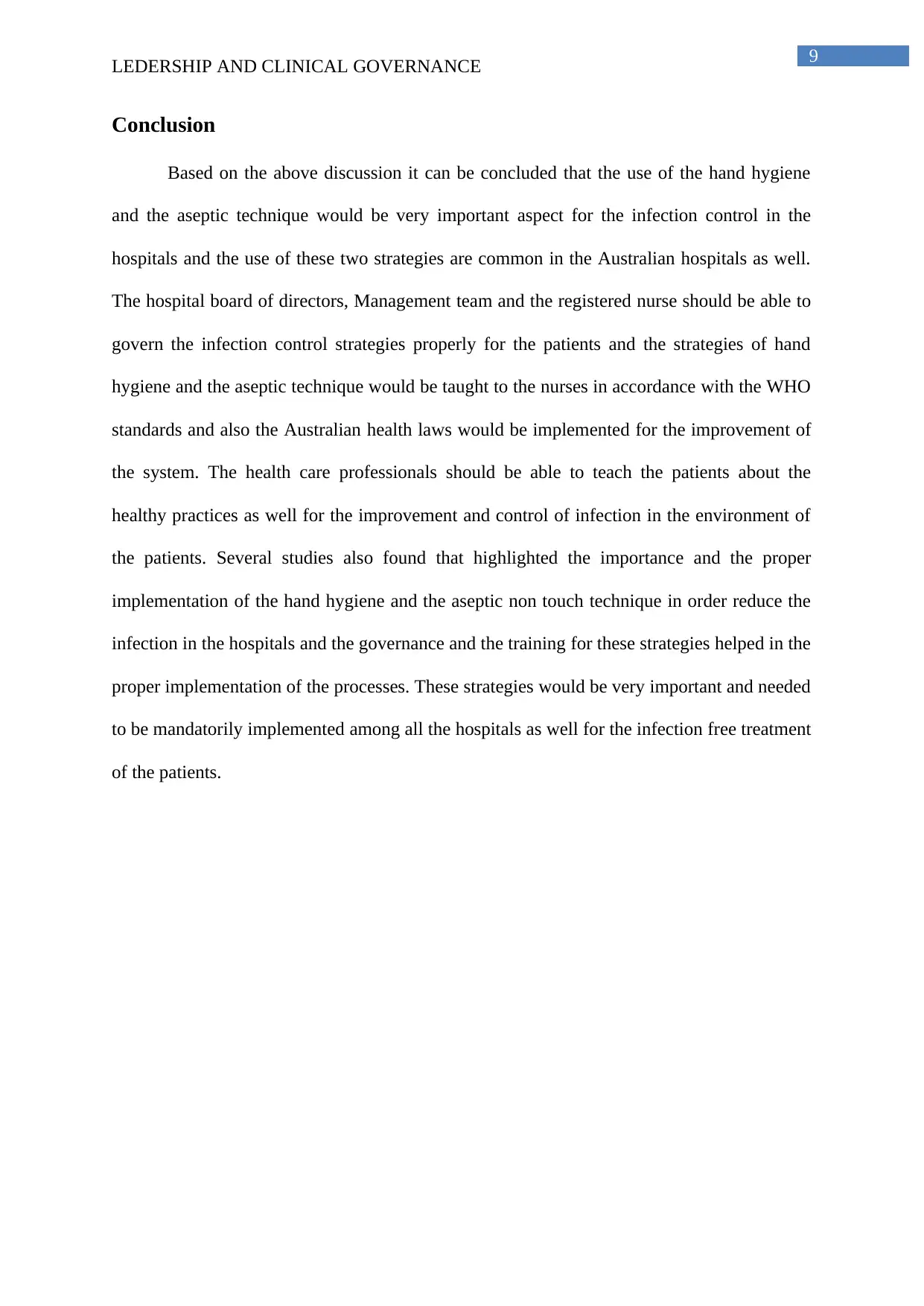
9
LEDERSHIP AND CLINICAL GOVERNANCE
Conclusion
Based on the above discussion it can be concluded that the use of the hand hygiene
and the aseptic technique would be very important aspect for the infection control in the
hospitals and the use of these two strategies are common in the Australian hospitals as well.
The hospital board of directors, Management team and the registered nurse should be able to
govern the infection control strategies properly for the patients and the strategies of hand
hygiene and the aseptic technique would be taught to the nurses in accordance with the WHO
standards and also the Australian health laws would be implemented for the improvement of
the system. The health care professionals should be able to teach the patients about the
healthy practices as well for the improvement and control of infection in the environment of
the patients. Several studies also found that highlighted the importance and the proper
implementation of the hand hygiene and the aseptic non touch technique in order reduce the
infection in the hospitals and the governance and the training for these strategies helped in the
proper implementation of the processes. These strategies would be very important and needed
to be mandatorily implemented among all the hospitals as well for the infection free treatment
of the patients.
LEDERSHIP AND CLINICAL GOVERNANCE
Conclusion
Based on the above discussion it can be concluded that the use of the hand hygiene
and the aseptic technique would be very important aspect for the infection control in the
hospitals and the use of these two strategies are common in the Australian hospitals as well.
The hospital board of directors, Management team and the registered nurse should be able to
govern the infection control strategies properly for the patients and the strategies of hand
hygiene and the aseptic technique would be taught to the nurses in accordance with the WHO
standards and also the Australian health laws would be implemented for the improvement of
the system. The health care professionals should be able to teach the patients about the
healthy practices as well for the improvement and control of infection in the environment of
the patients. Several studies also found that highlighted the importance and the proper
implementation of the hand hygiene and the aseptic non touch technique in order reduce the
infection in the hospitals and the governance and the training for these strategies helped in the
proper implementation of the processes. These strategies would be very important and needed
to be mandatorily implemented among all the hospitals as well for the infection free treatment
of the patients.
Paraphrase This Document
Need a fresh take? Get an instant paraphrase of this document with our AI Paraphraser
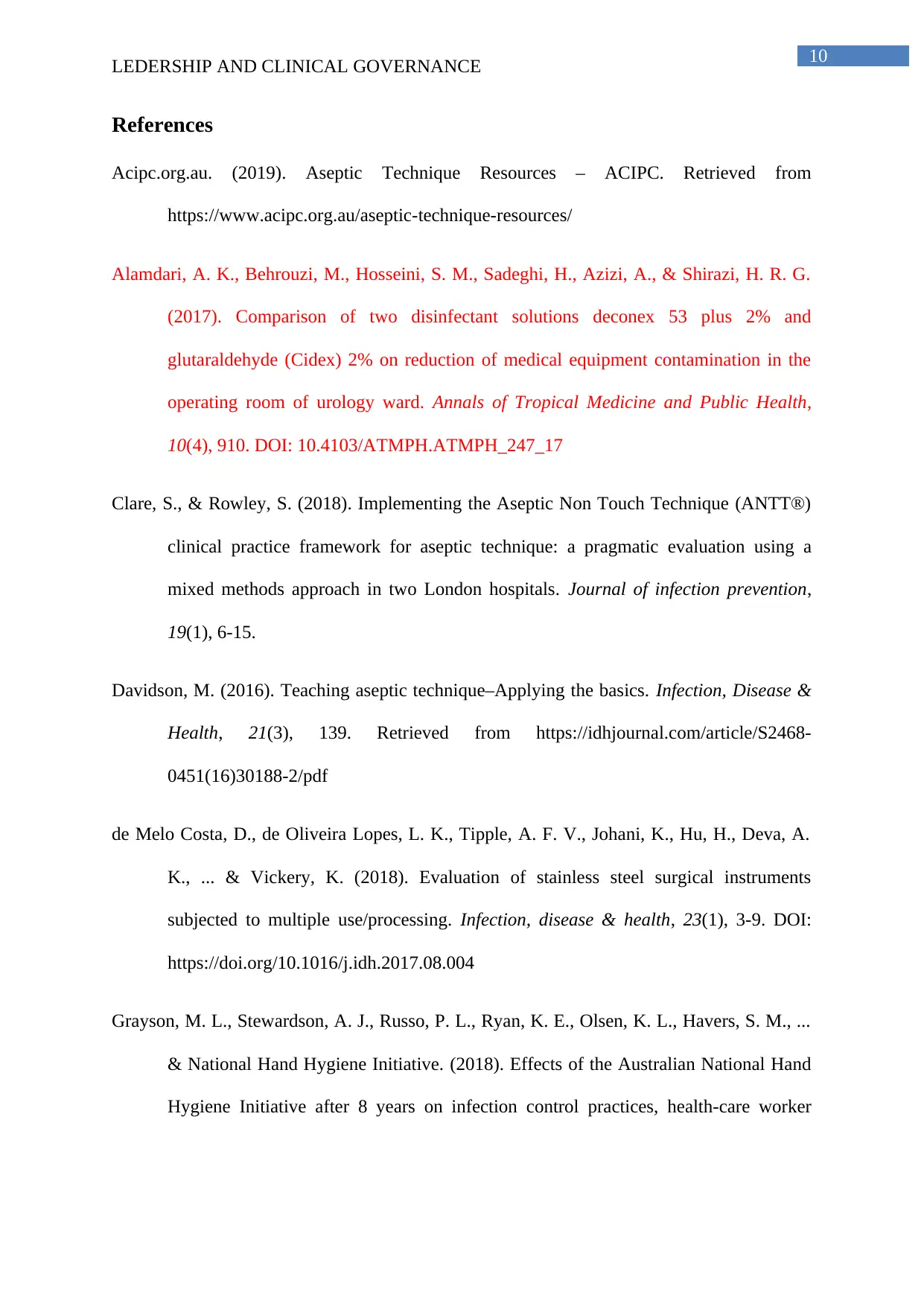
10
LEDERSHIP AND CLINICAL GOVERNANCE
References
Acipc.org.au. (2019). Aseptic Technique Resources – ACIPC. Retrieved from
https://www.acipc.org.au/aseptic-technique-resources/
Alamdari, A. K., Behrouzi, M., Hosseini, S. M., Sadeghi, H., Azizi, A., & Shirazi, H. R. G.
(2017). Comparison of two disinfectant solutions deconex 53 plus 2% and
glutaraldehyde (Cidex) 2% on reduction of medical equipment contamination in the
operating room of urology ward. Annals of Tropical Medicine and Public Health,
10(4), 910. DOI: 10.4103/ATMPH.ATMPH_247_17
Clare, S., & Rowley, S. (2018). Implementing the Aseptic Non Touch Technique (ANTT®)
clinical practice framework for aseptic technique: a pragmatic evaluation using a
mixed methods approach in two London hospitals. Journal of infection prevention,
19(1), 6-15.
Davidson, M. (2016). Teaching aseptic technique–Applying the basics. Infection, Disease &
Health, 21(3), 139. Retrieved from https://idhjournal.com/article/S2468-
0451(16)30188-2/pdf
de Melo Costa, D., de Oliveira Lopes, L. K., Tipple, A. F. V., Johani, K., Hu, H., Deva, A.
K., ... & Vickery, K. (2018). Evaluation of stainless steel surgical instruments
subjected to multiple use/processing. Infection, disease & health, 23(1), 3-9. DOI:
https://doi.org/10.1016/j.idh.2017.08.004
Grayson, M. L., Stewardson, A. J., Russo, P. L., Ryan, K. E., Olsen, K. L., Havers, S. M., ...
& National Hand Hygiene Initiative. (2018). Effects of the Australian National Hand
Hygiene Initiative after 8 years on infection control practices, health-care worker
LEDERSHIP AND CLINICAL GOVERNANCE
References
Acipc.org.au. (2019). Aseptic Technique Resources – ACIPC. Retrieved from
https://www.acipc.org.au/aseptic-technique-resources/
Alamdari, A. K., Behrouzi, M., Hosseini, S. M., Sadeghi, H., Azizi, A., & Shirazi, H. R. G.
(2017). Comparison of two disinfectant solutions deconex 53 plus 2% and
glutaraldehyde (Cidex) 2% on reduction of medical equipment contamination in the
operating room of urology ward. Annals of Tropical Medicine and Public Health,
10(4), 910. DOI: 10.4103/ATMPH.ATMPH_247_17
Clare, S., & Rowley, S. (2018). Implementing the Aseptic Non Touch Technique (ANTT®)
clinical practice framework for aseptic technique: a pragmatic evaluation using a
mixed methods approach in two London hospitals. Journal of infection prevention,
19(1), 6-15.
Davidson, M. (2016). Teaching aseptic technique–Applying the basics. Infection, Disease &
Health, 21(3), 139. Retrieved from https://idhjournal.com/article/S2468-
0451(16)30188-2/pdf
de Melo Costa, D., de Oliveira Lopes, L. K., Tipple, A. F. V., Johani, K., Hu, H., Deva, A.
K., ... & Vickery, K. (2018). Evaluation of stainless steel surgical instruments
subjected to multiple use/processing. Infection, disease & health, 23(1), 3-9. DOI:
https://doi.org/10.1016/j.idh.2017.08.004
Grayson, M. L., Stewardson, A. J., Russo, P. L., Ryan, K. E., Olsen, K. L., Havers, S. M., ...
& National Hand Hygiene Initiative. (2018). Effects of the Australian National Hand
Hygiene Initiative after 8 years on infection control practices, health-care worker
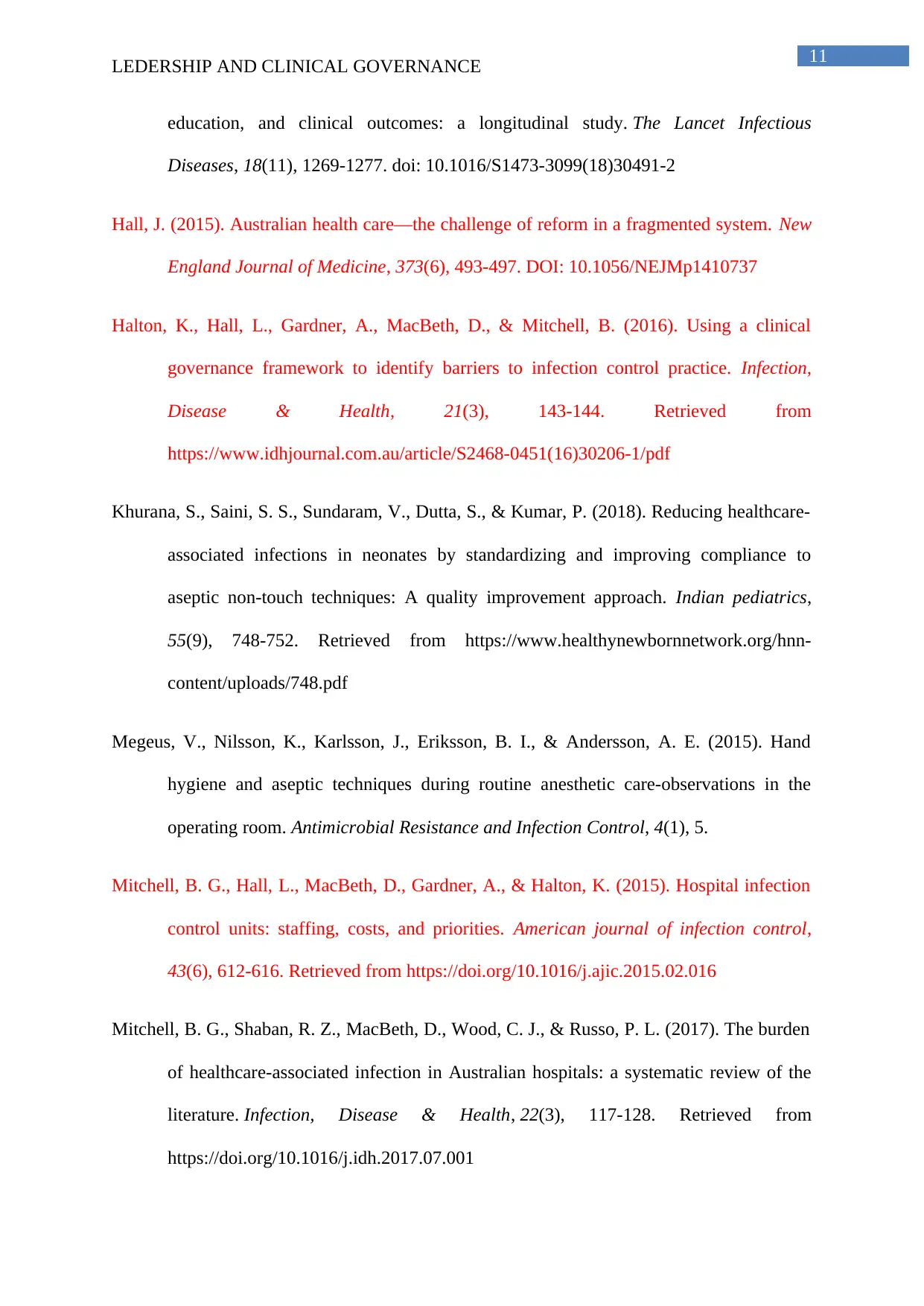
11
LEDERSHIP AND CLINICAL GOVERNANCE
education, and clinical outcomes: a longitudinal study. The Lancet Infectious
Diseases, 18(11), 1269-1277. doi: 10.1016/S1473-3099(18)30491-2
Hall, J. (2015). Australian health care—the challenge of reform in a fragmented system. New
England Journal of Medicine, 373(6), 493-497. DOI: 10.1056/NEJMp1410737
Halton, K., Hall, L., Gardner, A., MacBeth, D., & Mitchell, B. (2016). Using a clinical
governance framework to identify barriers to infection control practice. Infection,
Disease & Health, 21(3), 143-144. Retrieved from
https://www.idhjournal.com.au/article/S2468-0451(16)30206-1/pdf
Khurana, S., Saini, S. S., Sundaram, V., Dutta, S., & Kumar, P. (2018). Reducing healthcare-
associated infections in neonates by standardizing and improving compliance to
aseptic non-touch techniques: A quality improvement approach. Indian pediatrics,
55(9), 748-752. Retrieved from https://www.healthynewbornnetwork.org/hnn-
content/uploads/748.pdf
Megeus, V., Nilsson, K., Karlsson, J., Eriksson, B. I., & Andersson, A. E. (2015). Hand
hygiene and aseptic techniques during routine anesthetic care-observations in the
operating room. Antimicrobial Resistance and Infection Control, 4(1), 5.
Mitchell, B. G., Hall, L., MacBeth, D., Gardner, A., & Halton, K. (2015). Hospital infection
control units: staffing, costs, and priorities. American journal of infection control,
43(6), 612-616. Retrieved from https://doi.org/10.1016/j.ajic.2015.02.016
Mitchell, B. G., Shaban, R. Z., MacBeth, D., Wood, C. J., & Russo, P. L. (2017). The burden
of healthcare-associated infection in Australian hospitals: a systematic review of the
literature. Infection, Disease & Health, 22(3), 117-128. Retrieved from
https://doi.org/10.1016/j.idh.2017.07.001
LEDERSHIP AND CLINICAL GOVERNANCE
education, and clinical outcomes: a longitudinal study. The Lancet Infectious
Diseases, 18(11), 1269-1277. doi: 10.1016/S1473-3099(18)30491-2
Hall, J. (2015). Australian health care—the challenge of reform in a fragmented system. New
England Journal of Medicine, 373(6), 493-497. DOI: 10.1056/NEJMp1410737
Halton, K., Hall, L., Gardner, A., MacBeth, D., & Mitchell, B. (2016). Using a clinical
governance framework to identify barriers to infection control practice. Infection,
Disease & Health, 21(3), 143-144. Retrieved from
https://www.idhjournal.com.au/article/S2468-0451(16)30206-1/pdf
Khurana, S., Saini, S. S., Sundaram, V., Dutta, S., & Kumar, P. (2018). Reducing healthcare-
associated infections in neonates by standardizing and improving compliance to
aseptic non-touch techniques: A quality improvement approach. Indian pediatrics,
55(9), 748-752. Retrieved from https://www.healthynewbornnetwork.org/hnn-
content/uploads/748.pdf
Megeus, V., Nilsson, K., Karlsson, J., Eriksson, B. I., & Andersson, A. E. (2015). Hand
hygiene and aseptic techniques during routine anesthetic care-observations in the
operating room. Antimicrobial Resistance and Infection Control, 4(1), 5.
Mitchell, B. G., Hall, L., MacBeth, D., Gardner, A., & Halton, K. (2015). Hospital infection
control units: staffing, costs, and priorities. American journal of infection control,
43(6), 612-616. Retrieved from https://doi.org/10.1016/j.ajic.2015.02.016
Mitchell, B. G., Shaban, R. Z., MacBeth, D., Wood, C. J., & Russo, P. L. (2017). The burden
of healthcare-associated infection in Australian hospitals: a systematic review of the
literature. Infection, Disease & Health, 22(3), 117-128. Retrieved from
https://doi.org/10.1016/j.idh.2017.07.001
⊘ This is a preview!⊘
Do you want full access?
Subscribe today to unlock all pages.

Trusted by 1+ million students worldwide
1 out of 14
Related Documents
Your All-in-One AI-Powered Toolkit for Academic Success.
+13062052269
info@desklib.com
Available 24*7 on WhatsApp / Email
![[object Object]](/_next/static/media/star-bottom.7253800d.svg)
Unlock your academic potential
Copyright © 2020–2025 A2Z Services. All Rights Reserved. Developed and managed by ZUCOL.





